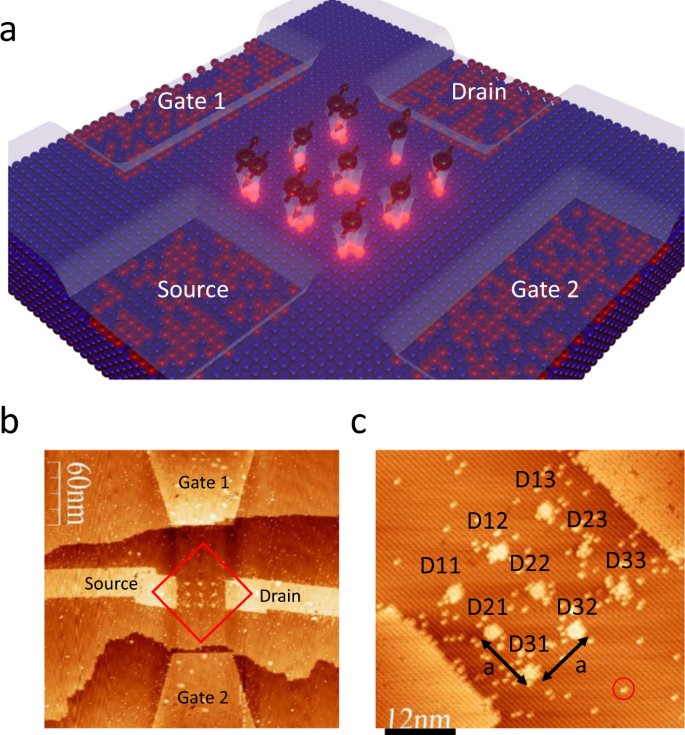2022-11-17 米国国立標準技術研究所(NIST)
今回の研究では、1個から3個のリン原子からなる量子ドットを、3×3のグリッド状に精密に並べて作製した。このグリッドに、電子を流すためのリード線などの部品を取り付けた。このグリッドは、電子がほぼ理想的な状態で振る舞うことができる競技場であり、現実の物質が引き起こす混乱の影響を受けない、教科書のような場所である。
研究者らは、電子をグリッドに注入し、ドットの間隔などの条件を変化させて、電子の振る舞いを観察した。ドットの間隔が近いグリッドでは、電子が広がって波のように振る舞う傾向があり、一度に複数の場所に存在することが本質的であった。ドットが離れていると、電子は個々のドットの中に閉じ込められ、絶縁体中の電子のようになることがある。
グリッドを進化させれば、制御可能な環境における電子の挙動を、世界で最も強力な従来のコンピューターでは正確にシミュレーションすることが不可能なレベルまで詳細に研究することができるようになる。これは、高温超伝導体などのエキゾチックな物質の秘密を解き明かす、本格的な「アナログ量子シミュレーター」への扉を開くものである。また、量子ドットアレイの形状を制御することで、トポロジカル絶縁体などの物質を作り出すヒントも得られるかもしれない。
<関連情報>
- https://www.nist.gov/news-events/news/2022/11/nists-grid-quantum-islands-could-reveal-secrets-powerful-technologies
- https://www.nature.com/articles/s41467-022-34220-w
- https://pubs.acs.org/doi/10.1021/acsnano.2c08162
ドーパントベースの量子ドットの2次元格子を用いた拡張フェルミ-ハバードモデルの実験的実現 Experimental realization of an extended Fermi-Hubbard model using a 2D lattice of dopant-based quantum dots
Xiqiao Wang,Ehsan Khatami,Fan Fei,Jonathan Wyrick,Pradeep Namboodiri,Ranjit Kashid,Albert F. Rigosi,Garnett Bryant & Richard Silver
Nature Communications Published:11 November 2022
DOI:https://doi.org/10.1038/s41467-022-34220-w

Abstract
The Hubbard model is an essential tool for understanding many-body physics in condensed matter systems. Artificial lattices of dopants in silicon are a promising method for the analog quantum simulation of extended Fermi-Hubbard Hamiltonians in the strong interaction regime. However, complex atom-based device fabrication requirements have meant emulating a tunable two-dimensional Fermi-Hubbard Hamiltonian in silicon has not been achieved. Here, we fabricate 3 × 3 arrays of single/few-dopant quantum dots with finite disorder and demonstrate tuning of the electron ensemble using gates and probe the many-body states using quantum transport measurements. By controlling the lattice constants, we tune the hopping amplitude and long-range interactions and observe the finite-size analogue of a transition from metallic to Mott insulating behavior. We simulate thermally activated hopping and Hubbard band formation using increased temperatures. As atomically precise fabrication continues to improve, these results enable a new class of engineered artificial lattices to simulate interactive fermionic models.
STMとDFTを用いたH-Si上のダングリングボンドへのホスフィン吸着による原子レベルの精密加工技術の向上 Enhanced Atomic Precision Fabrication by Adsorption of Phosphine into Engineered Dangling Bonds on H–Si Using STM and DFT
Jonathan Wyrick, Xiqiao Wang, Pradeep Namboodiri, Ranjit Vilas Kashid, Fan Fei, Joseph Fox, and Richard Silver
ACS Nano Published:November 1, 2022
DOI:https://doi.org/10.1021/acsnano.2c08162

Abstract
The doping of Si using the scanning probe hydrogen depassivation lithography technique has been shown to enable placing and positioning small numbers of P atoms with nanometer accuracy. Several groups have now used this capability to build devices that exhibit desired quantum behavior determined by their atomistic details. What remains elusive, however, is the ability to control the precise number of atoms placed at a chosen site with 100% yield, thereby limiting the complexity and degree of perfection achievable. As an important step toward precise control of dopant number, we explore the adsorption of the P precursor molecule, phosphine, into atomically perfect dangling bond patches of intentionally varied size consisting of three adjacent Si dimers along a dimer row, two adjacent dimers, and one single dimer. Using low temperature scanning tunneling microscopy, we identify the adsorption products by generating and comparing to a catalog of simulated images, explore atomic manipulation after adsorption in select cases, and follow up with incorporation of P into the substrate. For one-dimer patches, we demonstrate that manipulation of the adsorbed species leads to single P incorporation in 12 out of 12 attempts. Based on the observations made in this study, we propose this one-dimer patch method as a robust approach that can be used to fabricate devices where it is ensured that each site of interest has exactly one P atom.



